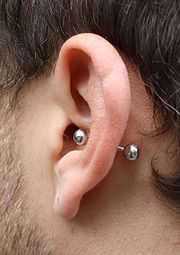Conch piercing
| Inner Conch piercing | |
|---|---|
 | |
| Location | Ear cartilage |
| Jewelry | captive bead ring, barbell, flesh plug, flesh tunnel |
| Healing | 6 months for primary healing, 12 to 18 for full healing |
A conch piercing is a perforation of the cartilage of the ear for the purpose of inserting and wearing jewelry. There are two types of conch piercings, inner and outer. The name is derived from the resemblance of this part of the ear to a conch (sea creature) shell.
Inner vs Outer Conch
The inner conch piercing is located at the center of the ear, the cup-shaped area adjacent to the ear canal. An outer conch piercing is positioned in the flat portion of the ear between the rim/edge (helix) and the ridge that defines the antihelix. Both piercings are performed in much the same manner as other ear cartilage piercings and cared for in the same way as well.
Procedure
The piercings are made using a hollow, hypodermic needle, typically around 14g or slightly larger. Most piercers agree that 16g should be the lowest limit for a healthy piercing. Once the hole has been made, straight or curved barbells are most often used during healing, although larger diameter CBRs (captive bead ring) are used as well. Many recipients report a significant amount of pain and soreness with these piercings, especially the inner conch.
Dermal Punch
Since stretching is almost impossible with cartilage (some people are able to stretch a size or two in smaller gauges), those wishing to attain a larger gauge piercing may opt for a dermal punch. This device functions similarly to a hole puncher for paper. A razor-sharp, circular blade protrudes and removes a clean disk of cartilage from the desired area. This procedure is far more common with outer conch piercings due to the area's flatness versus the much more concave shape of the inner conch in most individuals. Several clients describe the pain as comparable to a standard cartilage piercings, with others attesting that it actually hurts less.
Aftercare
Conch piercings are cared for just like other piercings in the ear cartilage. Sea salt soaks are recommended twice daily at a minimum to clean the piercing and jewelry, soften dried lymph, partially sterilize the area (via the salt), alleviate soreness and swelling, and promote blood flow to the area with the warm water in order to aid the healing process. Over-washing, the use of things such as alcohol and peroxide, and the use of antibiotic ointments should be avoided, as the former two will cause the wound to dry out, and the latter will cut off the air supply, both of which will inhibit healing. A competent piercer will recommend the best jewelry to wear while healing, and jewelry should not be removed or changed for at least eight weeks.
For those with a dermal punch in the area, the "piercing" is so large that it isn't strictly necessary to wear jewelry. The wound will in fact heal faster without jewelry, but one runs the risk of uneven healing, making for a less-than-circular hole and possibly leading to ill-fitting jewelry.
Jewellery
Smaller gauge conch piercings (generally considered sizes below 4g) can handle any standard body piercing jewelry however care must be taken in the case of CBRs or circular barbells that the diameter is large enough to fit around the ear, particularly in the case of inner conch piercings. Straight or curved barbells are most common with some people choosing large CBRs as well.
For larger gauge conch piercings, such as those achieved through a dermal punch, eyelets, plugs, and flesh tunnels can all be worn. It should be noted that as the inner conch is designed to help capture sound and funnel it into the ear canal, a hole in this area can lead to slight differences in hearing. The change is minimal and probably goes undetected by most people.
Complications
Most complications are common to those of other ear cartilage piercings. When getting the procedure done by a professional and following his or her instructions, along with proper hygiene and good health, these piercings should heal without incident. Migration and rejection are almost non-existent due to the depth at which both of these piercings are placed. Infection is the most serious concern to the client because of the multiple layers of cartilage being pierced. If not cared for properly, an infection can actually form between these layers of cartilage. As the infection lingers, it will begin eating away at the cartilage. The human body cannot replace cartilage, so once the infection clears up, parts of the ear can actually collapse without the necessary support.
| ||||||||||||||||||||||||||